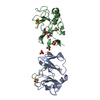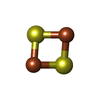+ Open data
Open data
- Basic information
Basic information
| Entry | Database: PDB / ID: 7yra | ||||||
|---|---|---|---|---|---|---|---|
| Title | Crystal structure of [2Fe-2S]-TtPetA | ||||||
 Components Components | Ubiquinol-cytochrome c reductase iron-sulfur subunit | ||||||
 Keywords Keywords |  ELECTRON TRANSPORT / Rieske / ELECTRON TRANSPORT / Rieske /  iron-sulfur cluster / iron-sulfur cluster /  metal binding metal binding | ||||||
| Function / homology |  Function and homology information Function and homology informationquinol-cytochrome-c reductase /  ubiquinol-cytochrome-c reductase activity / 2 iron, 2 sulfur cluster binding / intracellular membrane-bounded organelle / ubiquinol-cytochrome-c reductase activity / 2 iron, 2 sulfur cluster binding / intracellular membrane-bounded organelle /  metal ion binding / metal ion binding /  plasma membrane / plasma membrane /  cytoplasm cytoplasmSimilarity search - Function | ||||||
| Biological species |  Thermochromatium tepidum (bacteria) Thermochromatium tepidum (bacteria) | ||||||
| Method |  X-RAY DIFFRACTION / X-RAY DIFFRACTION /  SYNCHROTRON / SYNCHROTRON /  MOLECULAR REPLACEMENT / Resolution: 1.79 Å MOLECULAR REPLACEMENT / Resolution: 1.79 Å | ||||||
 Authors Authors | Tsutsumi, E. / Niwa, S. / Takeda, K. | ||||||
| Funding support |  Japan, 1items Japan, 1items
| ||||||
 Citation Citation |  Journal: Commun Chem / Year: 2023 Journal: Commun Chem / Year: 2023Title: Structure of a putative immature form of a Rieske-type iron-sulfur protein in complex with zinc chloride. Authors: Tsutsumi, E. / Niwa, S. / Takeda, R. / Sakamoto, N. / Okatsu, K. / Fukai, S. / Ago, H. / Nagao, S. / Sekiguchi, H. / Takeda, K. | ||||||
| History |
|
- Structure visualization
Structure visualization
| Structure viewer | Molecule:  Molmil Molmil Jmol/JSmol Jmol/JSmol |
|---|
- Downloads & links
Downloads & links
- Download
Download
| PDBx/mmCIF format |  7yra.cif.gz 7yra.cif.gz | 76 KB | Display |  PDBx/mmCIF format PDBx/mmCIF format |
|---|---|---|---|---|
| PDB format |  pdb7yra.ent.gz pdb7yra.ent.gz | 54.2 KB | Display |  PDB format PDB format |
| PDBx/mmJSON format |  7yra.json.gz 7yra.json.gz | Tree view |  PDBx/mmJSON format PDBx/mmJSON format | |
| Others |  Other downloads Other downloads |
-Validation report
| Arichive directory |  https://data.pdbj.org/pub/pdb/validation_reports/yr/7yra https://data.pdbj.org/pub/pdb/validation_reports/yr/7yra ftp://data.pdbj.org/pub/pdb/validation_reports/yr/7yra ftp://data.pdbj.org/pub/pdb/validation_reports/yr/7yra | HTTPS FTP |
|---|
-Related structure data
| Related structure data |  7yr9SC S: Starting model for refinement C: citing same article ( |
|---|---|
| Similar structure data | Similarity search - Function & homology  F&H Search F&H Search |
- Links
Links
- Assembly
Assembly
| Deposited unit | 
| ||||||||
|---|---|---|---|---|---|---|---|---|---|
| 1 |
| ||||||||
| Unit cell |
|
- Components
Components
-Protein , 1 types, 2 molecules AB
| #1: Protein | Mass: 16449.885 Da / Num. of mol.: 2 Source method: isolated from a genetically manipulated source Source: (gene. exp.)  Thermochromatium tepidum (bacteria) / Gene: petA / Production host: Thermochromatium tepidum (bacteria) / Gene: petA / Production host:   Escherichia coli (E. coli) / References: UniProt: D1MZ11, quinol-cytochrome-c reductase Escherichia coli (E. coli) / References: UniProt: D1MZ11, quinol-cytochrome-c reductase |
|---|
-Non-polymers , 5 types, 156 molecules 








| #2: Chemical |  Iron–sulfur cluster Iron–sulfur cluster#3: Chemical | ChemComp-SO4 /  Sulfate Sulfate#4: Chemical | ChemComp-CL / |  Chloride Chloride#5: Chemical |  Glycerol Glycerol#6: Water | ChemComp-HOH / |  Water Water |
|---|
-Details
| Has ligand of interest | Y |
|---|
-Experimental details
-Experiment
| Experiment | Method:  X-RAY DIFFRACTION / Number of used crystals: 1 X-RAY DIFFRACTION / Number of used crystals: 1 |
|---|
- Sample preparation
Sample preparation
| Crystal | Density Matthews: 2.51 Å3/Da / Density % sol: 50.93 % |
|---|---|
Crystal grow | Temperature: 293 K / Method: vapor diffusion, sitting drop / Details: 1.6 M AmS, 20% glycerol, 0.1 M Na-Ac pH 4.6 |
-Data collection
| Diffraction | Mean temperature: 15 K / Ambient temp details: He cryostream / Serial crystal experiment: N |
|---|---|
| Diffraction source | Source:  SYNCHROTRON / Site: SYNCHROTRON / Site:  SPring-8 SPring-8  / Beamline: BL41XU / Wavelength: 1 Å / Beamline: BL41XU / Wavelength: 1 Å |
| Detector | Type: DECTRIS EIGER X 16M / Detector: PIXEL / Date: Nov 24, 2020 |
| Radiation | Protocol: SINGLE WAVELENGTH / Monochromatic (M) / Laue (L): M / Scattering type: x-ray |
| Radiation wavelength | Wavelength : 1 Å / Relative weight: 1 : 1 Å / Relative weight: 1 |
| Reflection | Resolution: 1.79→50 Å / Num. obs: 30162 / % possible obs: 99.4 % / Redundancy: 3.4 % / CC1/2: 0.995 / Rsym value: 0.084 / Net I/σ(I): 10.1 |
| Reflection shell | Resolution: 1.79→1.9 Å / Num. unique obs: 4797 / CC1/2: 0.927 / Rsym value: 0.323 |
- Processing
Processing
| Software |
| ||||||||||||||||||
|---|---|---|---|---|---|---|---|---|---|---|---|---|---|---|---|---|---|---|---|
| Refinement | Method to determine structure : :  MOLECULAR REPLACEMENT MOLECULAR REPLACEMENTStarting model: 7YR9 Resolution: 1.79→50 Å / Cross valid method: THROUGHOUT
| ||||||||||||||||||
| Refinement step | Cycle: LAST / Resolution: 1.79→50 Å
| ||||||||||||||||||
| LS refinement shell | Resolution: 1.79→1.81 Å /
|
 Movie
Movie Controller
Controller



 PDBj
PDBj












